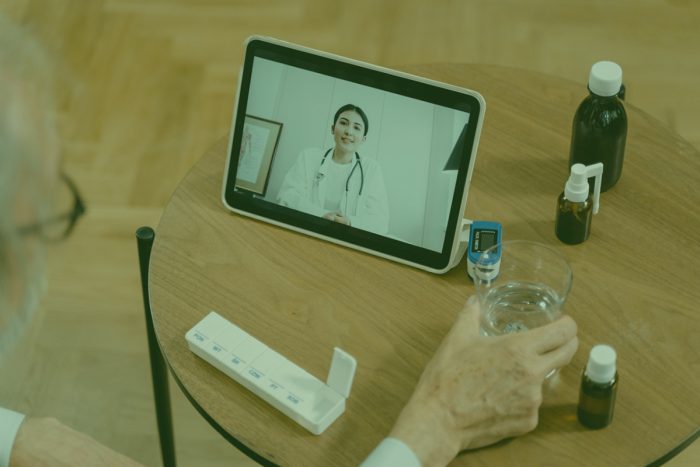The rise of telehealth advertising has been brewing for a while, although 2019 was when rapid growth really started to surface due to increasing customer demand. However, the recent COVID-19 pandemic sparked tremendous growth in the use of virtual health services. As a result of the pandemic, healthcare companies, providers, and patients were forced to adapt very quickly. And as consumers became exposed to telemedicine, they not only began to request such services—they actually expected them.
Just how much of a change was there in telemedicine adoption? The answer is staggering. In 2019, just 11% of U.S. healthcare consumers turned to telemedicine services; that is a little over one in every ten people. As of April 2020—within weeks of the pandemic really taking off—46% of U.S. healthcare consumers were resorting to telemedicine services; that’s practically one in every two people.
Everything from search trend data through market research reveals that the demand for telemedicine only continues to grow. This is not just a passing trend, which is being reflected in major policy changes both domestically and worldwide.
In 2020, both the World Health Organization (WHO) and the Centers for Disease Control (CDC) lifted several key restrictions that had previously limited the growth of telemedicine, to make these healthcare services more accessible to everyone during the pandemic. The CDC actually went so far as to issue extensive guidance regarding the use of different telehealth modalities. Synchronous (or real-time) patient communication, asynchronous messaging, and even remote patient monitoring (e.g., cardiac monitoring data submitted from a distance)
Global pandemic needs aside, one insight that has emerged because of the growth of telemedicine is evidence directly supporting the benefits it gives to all parties involved. Fully stepping into these benefits can help maximize their positive effects.
Benefits of Telehealth Advertising

There is a full range of benefits available for each stakeholder involved in telehealth services, from the health care providers through the patients. That said, likely the biggest winner is the patient.
Telemedicine cuts down radically on overhead costs, which brings savings via reduced costs and co-pays for patients. The increased appointment flexibility makes it easier for patients to pursue a consultation (good for medical practices), but also saves them time and money on travel arrangements, wait times, and even removing the need to take time off work. Overall, telemedicine delivers improved patient access to healthcare services.
Healthcare providers get the opportunity to provide care and support to people independent of their physical location, limitations of transportation or mobility, and time constraints. Telemedicine improves patient engagement and allows people to make their regular appointments more easily. Behind the desk, telehealth streamlines clinical workflows and increases practice efficiency—partly by cutting down on overhead bloat.
As more practices start to offer telehealth, it is vital that they adequately advertise their services.
Elements of Telehealth Advertising

As with all content marketing, effective telehealth advertisements must be mindful of the target audiences involved. Different generations or audiences may require different messaging for maximum impact, to address their concerns. Younger generations may be more comfortable with telehealth appointments, while older generations may be more skeptical, distrustful, or just less inclined to adopt it.
Paying attention to the different zip codes or geographic locations where telehealth advertising is being conducted is an important way to pay heed to the unique healthcare concerns that every different demographic may have. A people-first approach to advertising will always yield the best results. Patients are real people, and so your marketing communications need to be targeted to appeal directly to their needs.
It is critical to understand your audience and design your content to target that demographic. An important first step to this is to figure out what concerns may hold patients back from engaging with telemedicine appointments. What might instead drive them to actually book an appointment? By developing content that anticipates their questions and addresses their doubts upfront, you are more likely to successfully convert patients.
Of course, listening to audiences and directly addressing their needs with content is the cornerstone of good, effective marketing.
Strategies for Advertising Telehealth Services

One of the first steps should involve aiming to convert existing patients into telehealth users, as opposed to focusing solely on gaining all-new patients. After all, individuals already familiar with the practice are going to be more inclined to try something new—like a telehealth appointment—if they already know your practice and what to expect, overall.
In order to make gained insights meaningful, we need to take action. How do you effectively advertise telehealth services in a way that helps people overcome any hesitations they may have? How do you even get noticed instead of being diluted within the great sea of marketing messaging that is so pervasive these days?
Consider the strategies listed here as starting points for deploying your messaging. You can—and should—monitor engagement with the different strategies to identify which works best, and then sharpen that message further.
- Email marketing can use newsletters and focused messaging to highlight telehealth services;
- Adding messaging to patients’ billing statements, or any other essential documents that everyone receives, that note telehealth as an option;
- Sending out ads with promotions for patients to use on their first telehealth visit as a way to attract more business and entice more clients onboard;
- Traditional marketing methods like telehealth brochures or flyers in waiting rooms, next to the front desk, and in other highly-trafficked office locations;
- Social media marketing that pushes forward telehealth services as an option, possibly even linking to content that explains its benefits in detail;
- Paid search campaigns like Google Adwords and other PPC that target search intent around both telehealth and conventional office visits, but lead to optimized landing pages that highlight telehealth as an option —again, alongside noting its benefits;
- Organic SEO via detailed on-site explanations about telemedicine services offered, as well as insights about what telemedicine-related questions and searches come up (to inform future content that provides answers);
- Testimonials from patients who have used telehealth successfully and can highlight specific benefits, as well as marketing campaigns with patient reviews and statistics on satisfaction.
Successfully targeting your audience means leveraging every piece of information you can find about them, including demographics, geographic location, whether their friends follow your page, what their interests are, and so forth. There is insight to be gleaned from practically every type of data point you could identify.
Another key way to promote telehealth services is by creating a seamless experience for patients. This starts with a pre-visit workflow that can benefit both patients and the healthcare provider (as well as their team). Some features to consider as part of this workflow include:
- Clarity on the time and date of the telemedicine appointment, with details;
- The option to “Add Appointment to Calendar,” supporting common calendars including Outlook, iCal, and Google Calendar, including a link to the telehealth platform;
- Contact information that is readily available, in case any questions should come up;
- Clear notation of the specific technology requirements for telehealth sessions, including whether any downloads are needed;
- Step-by-step, visual and written instructions on how to access the virtual appointment;
- Readily available telehealth consent forms, which can be provided on the website as well as via email, to help facilitate compliance.
Of course, marketing automation should be leveraged here to schedule and send reminder emails ahead of patient appointments, as well as follow-up emails after their appointments.
How Good Apple Can Help
At the end of the day, telemedicine offers a radically improved user experience around visits that increases the accessibility of healthcare services for patients by maximizing flexibility. There is a need to focus on increasing user engagement and optimizing user experience so that it is more convenient, seamless, and productive.
But turning the introduction of a telehealth offering into a data-backed win is a bit more complicated, as tends to be the case with all marketing questions.
Here at Good Apple, we do the research so you don’t have to guess where or how to reach your audience. Through our work together, you will know which platform to use and how to personalize your messaging for each demographic or geographical group you serve.
Because healthcare marketing is our bread and butter, we have access to advanced analytics and exclusive tools that help us first to identify target audiences, and then to create the types of personalized messaging that will really resonate.
We have years of experience between us, during which time we have driven countless innovations and industry firsts. Good Apple has enjoyed many years of success with major, established companies, and has accumulated extensive industry knowledge. Together, using our time-tested and proven ad strategies, we can maximize the effectiveness of your advertising and overall ROI.
And if there’s something we don’t do ourselves? We have ongoing partnerships in place with other award-winning agencies, so that together we can provide an absolutely full-service experience.
One major thing we do for all our clients is help allocate business dollars effectively, particularly towards a robust marketing plan, and then working together to create a custom strategy that maximizes the budget.
We consult clients—from start to finish—on best practices in leveraging telehealth capabilities for media campaigns. Reach out to us today so we can explore how we can maximize your brand’s presence, including leveraging the recent boom in telemedicine to work for you.

